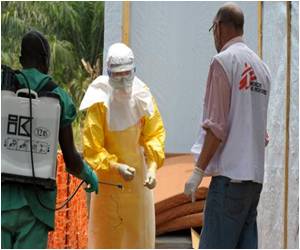In a remote Guinean village, when a toddler suddenly died from a mysterious fever last December, no one could have imagined it signalled the start of the worst-ever Ebola epidemic.

The virus first took hold in a triangle-shaped forested area where the porous borders of Guinea, Liberia and Sierra Leone meet.
"Ground zero" for the outbreak was an impoverished area where people are constantly crossing into neighbouring countries -- "a dream situation for a highly contagious virus," the World Health Organization said Tuesday.
The UN agency has tracked the first case back to a two-year-old boy who contracted an unknown illness in December in the remote Guinean village of Meliandou.
The boy, who suffered from fever, black stools and vomiting, died two days later.
The virus is believed to have been passed on by fruit bats, which are thought to be the natural reservoir of Ebola. Hunters are thought to have caught bat-infected monkeys, antelope, or squirrels for meat.
Advertisement
"In an ominous hint of what would come, one of these first cases died in Sierra Leone," the UN agency said, referring to how easily the virus has managed to spread between countries.
Advertisement
- 'No alarm bells rang' -
"Alarm bells might have gone off had any doctor or health official in the country ever seen a case of Ebola. No one had. No alarm bells rang," the WHO said.
Adding to the confusion, the affected area is notorious for outbreaks of cholera and other illnesses, and many Ebola symptoms are similar to endemic local diseases.
The virus continued its silent but lethal spread until staff from the Doctors Without Borders (MSF) charity sent a report on the strange deaths to a top expert in Geneva, who suspected a haemorrhagic fever, perhaps Ebola.
After spreading undetected for three months, the outbreak was finally officially declared on March 23.
Only four days later, the virus had made its way to Guinea's capital Conakry, as "new cases hit like sparks from a fire landing on dry grass," the WHO said.
"The brushfire had begun," the UN health agency said, describing the "heart-breaking" pattern that followed.
On three occasions, Guinea appeared set to quell the outbreak and began the count-down for the 21-day incubation period to pass without any new cases.
But each time, "vigilance eased and the sense of emergency lapsed," the agency said, explaining how Guinea -- which has now recorded more than 1,000 cases and 632 deaths -- and the international community let down their guard.
This allowed the virus, one of the deadliest known to man, to spread freely to neighbouring Liberia and Sierra Leone.
Liberia was quickly engulfed by the outbreak and is today by far the hardest-hit country, with almost 1,600 deaths.
Things got off to a better start in Sierra Leone, which confirmed its first Ebola case on May 24 and put the patient in isolation in Kenema the next day.
She recovered without infecting anyone else at the hospital.
"All the right precautions were taken," WHO said.
But the person who infected her -- a widely-respected traditional healer in Sierra Leone who had treated Ebola patients from Guinea -- was not tracked down, and is believed to be linked to as many as 365 Ebola deaths.
By mid-June, an explosive outbreak was underway in Sierra Leone's third city of Kenema, and soon also in the capital Freetown. The country has now recorded almost 600 people killed by Ebola.
Five researchers who helped to trace the cases to the healer were felled by the virus before their study was published.
Many other health professionals have also died in the country, including one of the world's leading experts on haemorrhagic fevers, Sheik Humarr Kahn.
Source-AFP










